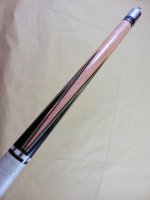There are certain dimensions and measurements which when used tend to give a cue more of a balabushka style look than other 4 pointed cues without these specs. These include:
~A 1.5" white delrin buttcap with a chocolate brown Brunswick Ku bumper that sticks out appx 1/8" from the bottom of the buttcap.
~A 2.5" buttsleeve. This may have varied slightly on some of his cues but EVERY balabushka butt sleeve I have seen has been this length and it gives his cues a very distinct look. Anything longer changes the look of the cue a lot. Tascarella uses a 2.75" sleeve and Szamboti uses a 3" sleeve. Balabushka used ebony (often inlaid with MOP dots and notched diamonds) or various plastics for the butt sleeve.
~4 SHORT points with 4 veneers. Balabushka most often used full splice or shorty spliced blanks from titlist blanks or blanks built by the Burton Spain/John Davis shop. These full splice blanks tend to have points that only come 6-7" from wrap to tip, and left appx 5-6" of maple forearm from the tips of the points to the bottom of the joint collar. This also gives a very distinct look, and I feel it is often overlooked when people attempt to build a Bushka copy or tribute. Most modern cues with short spliced forearms have 8-9" points which completely changes the look. This is one of the reasons why the Balabushka tribute cues made by Adam with George's "signature" on the forearm just don't look quite right. Also, Balabushka never built cues with the entire full splice pushed up into the cue's forearm as is seen on many modern blanks such as the current ones being produced by John Davis.
~Straight grain maple forearm. I do not believe George ever built a cue without a straight grain maple forearm. If he did it was rare. He felt birdseye was a sign of inferior maple. Also, Balabushka's finish (laquer i believe) had a tendency to yellow over time, so the maple in his forearms usually does not look snow white unless the cue has been refinished.
~1" stainless steel joint collar. Changing the length of the collar or using a material other than steel, such as ivory or phenolic, makes the cue look much less like a Bushka. Also, Balabushka used a 5/16x14 piloted joint. He may have used a different type on rare occasion but this was not common.
~1/2" black fibre trim rings at the joint with a thick nickel silver ring. The thinkness of the black ring may have varied slightly, but from what I have seen, 1/2" was pretty standard. I think I read somewhere once that Balabushka actually used real nickels for his joint trim rings, though this may not be accurate. I have also heard that thick silver rings like Bushka used are difficult to come by and some cuemakers have actually resorted to stacking two thinner rings on top of each other to achieve the look.
~Wrap. I believe Balabushka mostly used white w/green spec Cortland #9 linen and may have used other brands such as Penn linen. He may have used white w/ brown spec as well. He also occasionally did smooth black leather wraps.
~Balabushka cues, as well as most cues of the 1930-1980 era, had a fatter handle, around 1.27-1.3" diameter, and were shorter in length, usually around 57". I do not know if 12.5mm or 13mm was his standard tip diameter. I believe he made multiple shafts of varying lengths and diameters for his cues, mostly to customer request. For ferrules he used mostly ivory but may have sometimes used fibre ferrules as well. I am unsure what brand of tips were his standard, but I think it was a French brand (Chandivert?) or champion tips (I may be confusing this with Gus Szamboti).
Anyway, put these elements together and you will have a VERY Balabushka styled cue. This look of cue is what made me fall in love with pool cues in the first place and like the tuxedo, it will never go out of style.
To add: I also think it is funny that black and white checkered rings are often called "Bushka rings" although I have never actually seen this type of ring on a Balabushka cue. I know that George is famous for creating a "buzz ring" of phenolic located underneath the wrap where the forearm connected to the handle, but it was not visible, nor black and white checkered.
Hope this info helps
GB did not get "full-splice" blanks from Spain or Davis. All of the full-splice blanks he used came from Brunswick. He ONLY used shorty blanks from Spain and Davis.
Although GB preferred straight-grain maple, GB built several cues using curly maple blanks from Spain/Davis and BEM from Szamboti. Even some of the blanks he received from Brunswick when turned down on the lathe revealed some BEM spots.
Most of his cues were actually 57 1/2". As for tips and dimensions, GB did not build "standard" cues, so these items were mostly determined by customer request.
On the contrary, GB is credited for the "Buska" ring consisting of two nickel rings with ebony and phenolic dashes...which was very visible. He is also credited for creating the ring consisting of nickel rings, black phenolic, & white linen; mostly 7 bands in all. These are also called "Bushka" rings and are very visible!
With all said, many modern cuemakers build cues superior to GB's cues. However, the look and feel of a GB cue can only be replicated by a few modern cuemakers!
Last edited:







